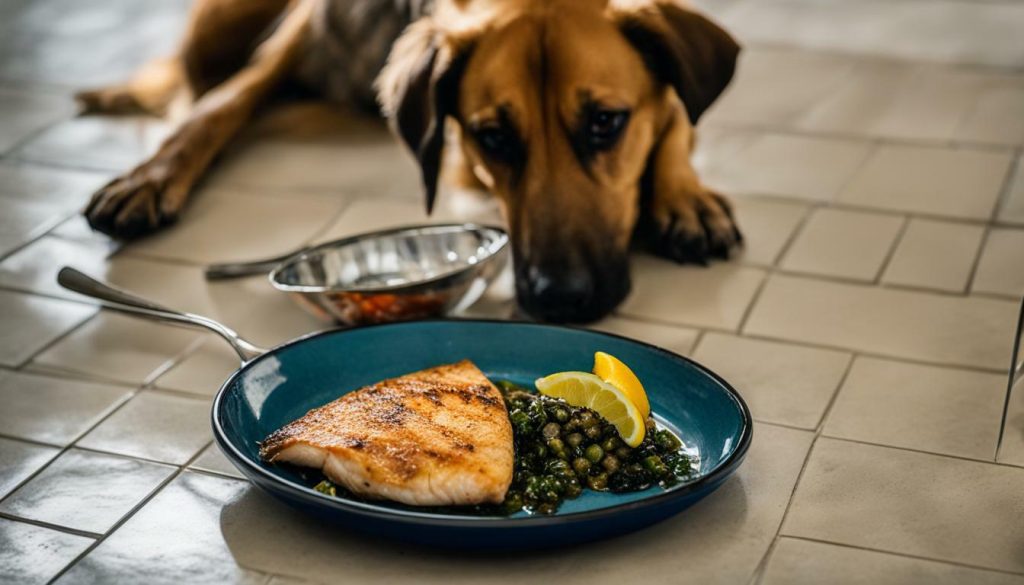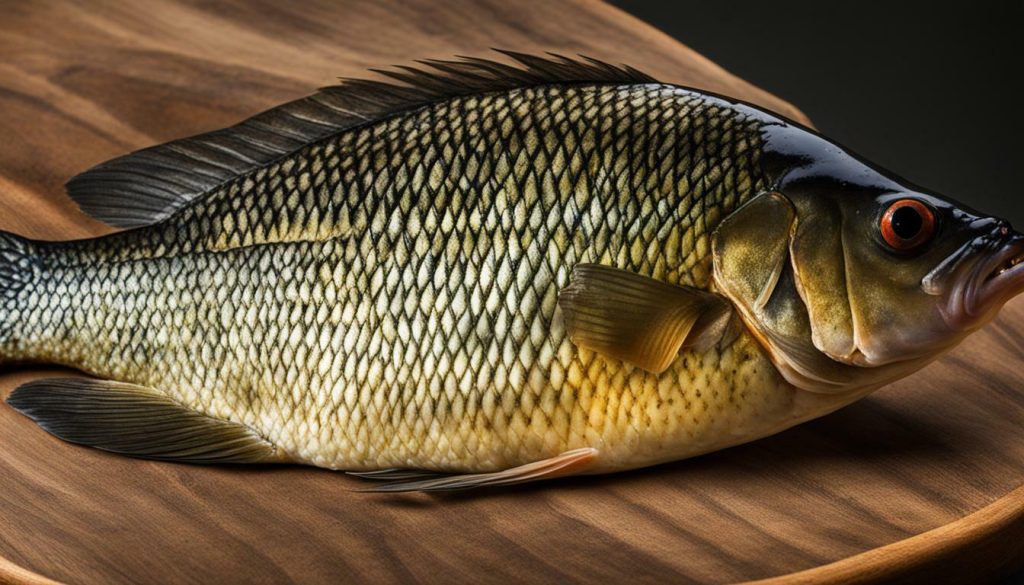
If you’re wondering whether dogs can safely consume tilapia, this guide will provide you with all the information you need to make an informed decision about your furry friend’s diet.
- Tilapia can be safe for dogs when cooked and deboned properly.
- It is a lean source of protein and contains beneficial nutrients like omega-3 fatty acids, vitamin D, and vitamin B12.
- Raw or undercooked tilapia can be harmful to dogs due to the potential presence of parasites and bacteria.
- Consult with your veterinarian before introducing tilapia or any changes to your dog’s diet.
- Remove the skin and avoid seasoning or frying the fish for your dog’s optimal health.
Now, let’s explore the safety and nutritional benefits of feeding tilapia to your canine companion.
Is Tilapia Safe for Dogs?
When it comes to including tilapia in your dog’s diet, safety is of utmost importance. Let’s delve into whether tilapia is safe for your canine companion to consume. Tilapia can be a nutritious addition to your dog’s diet, as it is a lean source of protein and contains essential nutrients like omega-3 fatty acids, vitamin D, and vitamin B12.
However, it is crucial to ensure that the tilapia is cooked thoroughly and deboned properly before offering it to your dog. Raw or undercooked fish can harbor parasites and bacteria that can cause stomach upset and other complications in dogs. Proper cooking methods, such as baking, boiling, or grilling, can help eliminate any potential health risks.
Consulting with a veterinarian is highly recommended before introducing tilapia or any new food into your dog’s diet. They can provide personalized advice based on your dog’s specific needs, taking into account any dietary restrictions or health conditions. Your veterinarian can guide you on the appropriate portion sizes and frequency of feeding tilapia to your dog.
| Risks of Feeding Tilapia to Dogs | Precautions for Feeding Tilapia to Dogs |
|---|---|
|
|
Tilapia should be given to dogs in moderation as an occasional snack and should not exceed 10% of their daily caloric intake. It is also essential to consider the overall balance of their diet and ensure they receive a variety of nutrients from different sources. By following proper guidelines and consulting with your veterinarian, you can safely incorporate tilapia into your dog’s diet and provide them with a delicious and nutritious treat.
The Nutritional Benefits of Tilapia for Dogs
Besides being safe, tilapia offers several nutritional benefits that can positively impact your dog’s health. Let’s explore why tilapia can be a good addition to your canine’s diet.
Tilapia is a lean source of protein, which is essential for building and repairing tissues in your dog’s body. Protein also plays a crucial role in supporting a healthy immune system and promoting overall growth and development. Incorporating tilapia into your dog’s diet can help ensure they receive an adequate amount of this vital nutrient.
In addition to protein, tilapia is rich in omega-3 fatty acids. These fatty acids have anti-inflammatory properties that can benefit dogs with joint issues, allergies, or skin conditions. Omega-3 fatty acids also support cognitive function and can aid in maintaining a healthy coat and skin.

Tilapia is also a good source of vitamins, particularly vitamin D and vitamin B12. Vitamin D plays a crucial role in calcium absorption and bone health, while vitamin B12 is essential for the proper functioning of the nervous system and the production of red blood cells. Including tilapia in your dog’s diet can help ensure they receive these important vitamins.
Summary
When cooked and deboned properly, tilapia can be a safe and nutritious addition to your dog’s diet. It offers a lean source of protein, omega-3 fatty acids, and important vitamins. Remember to consult with your veterinarian before making any changes to your dog’s diet and always feed tilapia in moderation, accounting for no more than 10% of their daily caloric intake.
Guidelines for Feeding Tilapia to Dogs
To ensure your dog reaps the benefits of tilapia while minimizing potential risks, it’s crucial to follow some guidelines when it comes to feeding this fish to your furry friend.
1. Cook and Debone Properly: Always cook tilapia thoroughly to eliminate any harmful bacteria or parasites that may be present. Avoid using seasonings, as some spices like garlic and onion can be toxic to dogs. Additionally, take the time to carefully debone the fish to prevent any choking hazards.
2. Portion Sizes: When offering tilapia to your dog, it’s important to consider the portion size. Too much fish can disrupt their balanced diet and lead to digestive issues. As a general guideline, tilapia should make up no more than 10% of your dog’s daily caloric intake.
3. Frequency of Feeding: Tilapia should be given to your dog occasionally as a special treat rather than a regular meal. It’s recommended to consult with your veterinarian to determine the frequency that suits your dog’s individual needs.

4. Consulting with a Veterinarian: Before introducing tilapia or any other new food into your dog’s diet, it’s essential to consult with a veterinarian. They can provide personalized advice based on your dog’s health, dietary requirements, and any specific conditions they may have.
By following these guidelines, you can ensure that feeding tilapia to your dog is a safe and enjoyable experience. Remember that every dog is different, so it’s important to monitor their reaction to new foods and make adjustments accordingly. With the proper precautions in place, tilapia can be a nutritious addition to your dog’s diet.
Risks and Precautions of Feeding Tilapia to Dogs
While tilapia can be safe for dogs, it’s essential to be aware of potential risks and take necessary precautions to ensure your dog’s well-being. Raw or undercooked fish can contain harmful parasites and bacteria that can cause stomach upset and other complications in dogs. To protect your furry friend, always ensure that the tilapia is cooked thoroughly before feeding it to them. Cooking the fish at a high temperature will help kill any potential pathogens.
Another important precaution is to remove the skin from the tilapia before serving it to your dog. The skin can be difficult for dogs to digest and may lead to gastrointestinal issues. Additionally, it is advised to avoid seasoning or frying the fish for your dog. These additives can be harmful to their health and may cause unnecessary stress on their digestive system.
Consulting with a veterinarian is crucial before introducing tilapia or any new food into your dog’s diet. A veterinarian will be able to assess your dog’s specific dietary needs and provide personalized advice. They can recommend the appropriate portion size and frequency of feeding tilapia based on your dog’s age, size, and overall health.
Remember, moderation is key when it comes to feeding tilapia to dogs. While tilapia can be a healthy addition to their diet, it should be given as an occasional snack and should not exceed 10% of their daily caloric intake. Keeping a balanced and varied diet for your dog is essential to ensure they receive all the necessary nutrients they need for optimal health.

| Risks and Precautions of Feeding Tilapia to Dogs | |
|---|---|
| Thoroughly cook the tilapia to kill potential pathogens. | Be cautious of raw or undercooked fish. |
| Remove the skin before serving to prevent digestive issues. | Avoid skin for easy digestion. |
| Avoid seasoning and frying the fish for your dog. | Keep it simple and natural. |
| Consult with a veterinarian before introducing tilapia. | Seek professional advice. |
| Feed tilapia in moderation, not exceeding 10% of daily caloric intake. | Balance is key for a healthy diet. |
Other Fish Options for Dogs
If your dog isn’t a fan of tilapia or you’re looking to diversify their fish intake, there are other fish options that can provide similar nutritional benefits. Fish is a great source of protein for dogs and can contribute to their overall health and well-being. Here are a few other fish varieties that you can consider adding to your dog’s diet:
- Salmon: Rich in omega-3 fatty acids, salmon can help support your dog’s skin and coat health and promote a healthy immune system.
- Tuna: High in protein and low in fat, tuna is a good option for dogs who need a lean source of protein. However, it should be fed in moderation due to its high mercury content.
- Sardines: Packed with omega-3 fatty acids, sardines are a small fish that can be fed whole or mashed up and added to your dog’s food for an extra boost of nutrition.
- Whitefish: Whitefish, such as cod or haddock, is a mild-tasting fish that can be a good alternative to tilapia. It is low in fat and high in protein, making it a nutritious choice for your dog.
When introducing new fish to your dog’s diet, it is important to start with small portions and monitor for any signs of digestive upset. Always consult with your veterinarian to determine the best fish options for your dog based on their individual dietary needs and health conditions.
| Fish Variety | Nutritional Benefits |
|---|---|
| Salmon | High in omega-3 fatty acids, protein, and vitamin D |
| Tuna | Rich in protein, low in fat, and a good source of omega-3 fatty acids |
| Sardines | High in omega-3 fatty acids, calcium, and vitamin D |
| Whitefish | Low in fat, high in protein, and a good source of omega-3 fatty acids |
“Feeding your dog a variety of fish can help provide them with essential nutrients and keep their meals interesting. Just remember to always cook the fish thoroughly, remove any bones, and avoid seasoning or frying it for your dog’s health and safety.” – Dr. Amanda Brown, Veterinarian
By offering a variety of fish options, you can ensure that your dog receives a well-rounded and nutritious diet. Remember to introduce new fish gradually, monitor your dog’s response, and consult with your veterinarian for personalized advice.

Consulting with Your Veterinarian
Before incorporating tilapia into your dog’s diet, it’s always wise to consult with your trusted veterinarian who can offer personalized guidance based on your dog’s individual requirements. They will be able to assess your dog’s overall health, dietary needs, and any potential allergies or sensitivities that may affect their ability to consume tilapia.
Your veterinarian will be able to recommend the appropriate portion sizes and frequency of feeding tilapia to your dog. They can also advise you on the best cooking methods to ensure that the fish is prepared safely and free from any harmful parasites or bacteria.
Remember, each dog is unique, and what works for one may not work for another. By speaking with your veterinarian, you can make informed decisions about whether tilapia is suitable for your dog’s diet and how to incorporate it in a way that promotes their overall health and well-being.

Preparation Tips for Feeding Tilapia to Dogs
To make tilapia a healthy and enjoyable addition to your dog’s diet, here are some preparation tips to keep in mind:
- Cook it thoroughly: Raw or undercooked fish can pose health risks to dogs, so it’s important to ensure that the tilapia is cooked properly before serving it to your furry friend. Cooking the fish thoroughly will help eliminate any potential parasites or bacteria that could cause stomach upset or other complications.
- Debone the fish: Before feeding tilapia to your dog, make sure to thoroughly debone it. Fish bones can pose a choking hazard and may cause injury to your dog’s digestive tract. Remove all the bones from the fillet to ensure a safe meal.
- Remove the skin: While the skin of tilapia is edible for humans, it can be tough and difficult for dogs to digest. It’s best to remove the skin before feeding tilapia to your dog to prevent any gastrointestinal issues.
- Avoid seasoning and frying: Dogs have sensitive stomachs, and certain seasonings and frying methods can be harmful to them. Keep the tilapia plain and avoid adding any salt, spices, or oils. Keeping it simple will ensure that your dog can enjoy the fish without any adverse effects.
Remember, moderation is key when it comes to feeding tilapia to dogs. It should be given as an occasional snack or part of a balanced meal, and it should not exceed 10% of your dog’s daily caloric intake. Consulting with a veterinarian is always recommended before introducing any new food into your dog’s diet, including tilapia.

Following these preparation tips will help you ensure that tilapia is a safe and nutritious choice for your canine companion. By providing a lean source of protein and essential nutrients, tilapia can be a healthy and enjoyable addition to your dog’s diet.
| Pros | Cons |
|---|---|
| Tilapia is a lean source of protein. | Raw or undercooked tilapia can cause health issues. |
| Contains omega-3 fatty acids, vitamin D, and vitamin B12. | Tilapia skin can be tough for dogs to digest. |
| Can be a healthy and occasional snack for dogs. | Tilapia should not exceed 10% of a dog’s daily caloric intake. |
Moderation and Portion Control
While tilapia can be a nutritious addition to your dog’s diet, it’s crucial to practice moderation and portion control to maintain a balanced canine diet. Incorporating tilapia into your dog’s meals can provide them with essential nutrients like omega-3 fatty acids, vitamin D, and vitamin B12. However, too much of a good thing can have negative consequences for your furry friend.
When it comes to feeding your dog tilapia, it’s important to consider their overall caloric intake. Tilapia should only make up a small portion of their daily diet, typically not exceeding 10% of their total caloric needs. This ensures that they are receiving a balanced mix of proteins, carbohydrates, fats, and other necessary nutrients from other sources as well.
Portion control is equally important. While it may be tempting to give your pup a large serving of tilapia, it’s best to stick to appropriate portion sizes. Your veterinarian can provide guidance on the ideal serving size based on your dog’s size, age, weight, and activity level. By following their recommendations, you can ensure that your dog enjoys the health benefits of tilapia without any negative impact on their overall well-being.
Remember, every dog is unique, and individual dietary needs may vary. Consulting with a veterinarian is always recommended before introducing any new food into your dog’s diet, including tilapia. They can provide personalized advice based on your dog’s specific health conditions and dietary requirements.
| Tips for Moderation and Portion Control: | 1 | 2 | 3 |
|---|---|---|---|
| Avoid overfeeding | Consult with a veterinarian | Consider your dog’s overall caloric needs |

“Feeding tilapia to your dog can be a healthy choice, but it’s essential to strike a balance. Moderation and portion control are key when it comes to incorporating tilapia into your dog’s diet.” – Dr. Amanda Smith, DVM
- Introduce tilapia gradually and observe your dog’s response. If they experience any digestive issues or allergic reactions, discontinue feeding tilapia and consult with your veterinarian.
- Remove the skin from tilapia before serving it to your dog. Fish skin can be difficult to digest and may cause gastrointestinal discomfort.
- Avoid seasoning or frying the fish for your dog. While you may enjoy your tilapia seasoned or fried, added spices or oils can be harmful to your dog’s health.
- Proper storage is important to prevent spoilage. Keep tilapia fresh by refrigerating or freezing it according to recommended guidelines.
Removing Skin and Avoiding Seasonings
To ensure the optimal safety and health of your furry friend, it’s essential to remove the skin from tilapia and avoid adding any seasonings before serving it to your dog. The skin can be tough to digest and may contain oils or seasonings that can upset your dog’s stomach. By removing it, you eliminate the risk of digestive issues and potential allergies.
Seasonings like salt, pepper, garlic, and onion can be harmful to dogs, causing adverse effects such as anemia, gastrointestinal problems, and even poisoning. It’s best to keep the fish plain and free from any added flavors. Remember, dogs have more sensitive taste buds than humans, so they don’t require the same level of seasoning to enjoy their food.
When cooking tilapia for your canine companion, it’s important to remember that they have different dietary needs than humans. While you may prefer your fish fried or seasoned, it’s best to prepare tilapia for your dog by baking, grilling, or boiling it. These cooking methods retain the nutritional value of the fish without adding unnecessary fats or seasonings.
| Tips for Feeding Tilapia to Dogs: |
|---|
| 1. Remove the skin before serving the tilapia to your dog. |
| 2. Avoid adding any seasonings, including salt, pepper, garlic, or onion. |
| 3. Cook the tilapia through baking, grilling, or boiling to retain its nutritional value. |
| 4. Serve the tilapia in small, bite-sized portions suitable for your dog’s size. |
| 5. Monitor your dog for any adverse reactions or gastrointestinal issues after introducing tilapia to their diet. |
By following these guidelines, you can safely incorporate tilapia into your dog’s diet as an occasional treat or as part of a balanced meal. Always keep in mind that each dog is unique, so consulting with your veterinarian before introducing any new food is crucial to ensure the optimal well-being of your furry friend.

In conclusion, tilapia can be safely incorporated into your dog’s diet when cooked and prepared properly, but it’s crucial to prioritize their safety and nutritional needs by consulting with a veterinarian and following recommended guidelines.
Tilapia is a lean source of protein that can provide essential nutrients such as omega-3 fatty acids, vitamin D, and vitamin B12 for your dog’s overall health. However, it is important to note that raw or undercooked fish can pose risks to your dog’s digestive system due to potential parasites and bacteria.
Before introducing tilapia or any new food into your dog’s diet, consult with a veterinarian. They can provide personalized advice on your dog’s specific dietary requirements and help you determine appropriate portion sizes and frequencies.
When preparing tilapia for your dog, make sure to remove the skin to avoid any additional fat or seasonings that could be harmful to their health. It is recommended to cook the fish thoroughly, ensuring it is fully deboned to prevent any choking hazards.
Remember that tilapia should be given in moderation as an occasional snack, and it should not exceed 10% of your dog’s daily caloric intake. By following these guidelines and considering your dog’s individual needs, tilapia can be a safe and nutritious addition to their diet.
FAQ
Can dogs eat tilapia?
Yes, dogs can eat tilapia as long as it is cooked and deboned properly.
Is tilapia safe for dogs?
When prepared correctly, tilapia can be safe for dogs to eat.
What are the nutritional benefits of tilapia for dogs?
Tilapia is a lean source of protein and contains nutrients like omega-3 fatty acids, vitamin D, and vitamin B12.
How should I feed tilapia to my dog?
It is important to consult with a veterinarian before introducing tilapia to your dog’s diet. Cook the tilapia thoroughly, remove the skin, and avoid seasoning or frying it.
Are there any risks or precautions associated with feeding tilapia to dogs?
Raw or undercooked fish can contain harmful parasites and bacteria that can cause stomach upset and other complications in dogs. It is important to consult with a veterinarian and follow proper preparation methods.
Can dogs eat other types of fish?
Besides tilapia, there are other types of fish that are safe and beneficial for dogs. Your veterinarian can provide guidance on alternative fish options.
Should I consult with my veterinarian before feeding tilapia to my dog?
Yes, it is important to consult with a veterinarian before making any changes to your dog’s diet, including introducing tilapia. They can provide advice tailored to your dog’s specific needs.
What are some preparation tips for feeding tilapia to dogs?
When feeding tilapia to dogs, make sure to properly cook, debone, and serve it to ensure it is safe and enjoyable for your dog.
How much tilapia can I feed my dog?
Tilapia should be given in moderation as an occasional snack and should not exceed 10% of your dog’s daily caloric intake.
Should I remove the skin and avoid seasonings when feeding tilapia to dogs?
Yes, it is recommended to remove the skin from tilapia and avoid seasoning or frying it for your dog’s health.






